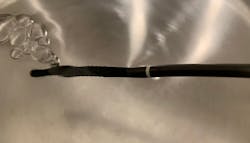How can SPD address the patient safety gap with flexible endoscopes?
An addition to ST91 is a requirement to document and report, according to hospital procedures, leak test failures.
AAMI ST91 7.4.8.d. reads, “Report the leak test failure per organizational policy and procedure, including the endoscope product identification and traceability information.” Recall that leak testing is a vital part of the process done prior to washing to detect a leak and prevent endoscope flooding during the washing process. While this new standard requirement is a move in the right direction, it falls short of what is needed to protect patients from harm.
Only the exterior of the endoscope and the interior of the lumens are rendered sterile or high-level disinfected through reprocessing. A flexible endoscope is a device where the working components are enclosed by the exterior cover. As an example, think of your car when you drive it through an automated car wash. Only the exterior of the car is cleaned, not the engine compartment, interior or trunk. The difference between your car and a flexible endoscope is that you can access the engine compartment, interior and trunk of the car to clean it.
Flexible endoscopes are designed to be water-tight, and there are no user serviceable interior components. Thus, there is no way for an end user to access the interior of the endoscope to clean or sterilize it. Leak testing pressurizes the interior of the endoscope so that a leak can be found. When a leak forms, the interior of the endoscope is opened to the exterior. Endoscopes that are sterilized by hydrogen peroxide or ozone gas require a vent port be attached during sterilization. The vent port allows the pressure change inside the endoscope to match the pressure change in the sterilization chamber as a vacuum is pulled. If the vent cap was not in place, the endoscope would burst as the pressure inside the endoscope tries to fill the vacuum that was formed in the sterilizer. While sterilant penetrates the interior of the endoscope, this space is not considered sterile because it is not a clean area. Every IFU indicates that it is unsafe to use a damaged or leaking endoscope on a patient. No clinician would purposely allow a leaking endoscope to be used on a patient.
IFUs, manufacturer standards and the FDA all recognize the dangers of a leaking flexible endoscope. For example:
- Olympus: Perform a leakage test on the endoscope after each precleaning procedure. Do not use the endoscope if a leak is detected. Use of an endoscope with a leak may cause a sudden loss of the endoscopic image, damage to the bending mechanism, or other malfunctions. Use of a leaking endoscope may also pose an infection control risk.1
- Pentax: Warning: Use of a leaking endoscope results in partial or unsuccessful reprocessing.2
- AAMI ST91: All endoscopy procedures pose risks to patients. The introduction of pathogens through use of contaminated endoscopes is an appreciable risk that can be mitigated.3
- FDA: Do not use damaged devices or those that have failed a leak test, as they could be a potential source of contamination. 4
Exposing the gap
Today leak testing is performed prior to cleaning and in most AERs. Most of the damage to flexible endoscopes occurs during use and the most frequent form of damage is a leak. Damage frequently is a result of the use of accessory devices (e.g., biopsy forceps, snares, laser fibers, etc.), improper handling (e.g., bending, torquing, rough handling, etc.) improper care (e.g., sharps, heavy equipment placed on or near the endoscopes, etc.) and general wear and tear (parts sometimes just fail).
The primary systems of a flexible endoscope are the mechanical (angulation stiffness), image system (electrical/ fiber optic image capture and transmission) and the seals that keeps the endoscope water-tight. During use, physicians can only detect damage to the mechanical and image systems. The integrity of seals that protects the patient from exposure to the non-sterile/ non-high-level disinfected interior of the endoscope is not feedback that the physician receives when using the endoscope.
AAMI ST91 new documentation and notification requirement and all other standards (AORN, SGNA, FDA) should require notification to the physician that the patient may have been exposed to a non-sterile/non-high-level disinfected endoscope when it is discovered post case that the endoscope has a leak. When a leak occurs, the endoscope can no longer be considered sterile or high-level disinfected and should not be used on a patient from that point in time when the leak occurred. Notification of a leak post-case is not a perfect solution because the patient likely was exposed to a non-sterile/non-high-level disinfected endoscope, which is a health risk to the patient. The new standard to report and record leaks could assist physicians in the treatment of their patients and bring heightened awareness of monitoring those patients that were exposed to a non-sterile/non-high-level disinfected endoscope during a procedure.
Consider that if any other surgical instrument (e.g., scissors, forceps, grasper, etc.) was found to be contaminated in the OR, significant actions would be taken, including immediately removing the instrument and any instruments that the contaminated instrument contacted. Staff would record the event in the hospitals event tracking system. Infection prevention and the SPD would be notified. If the contaminated instrument was used on the patient, the physician would likely follow the patient closely and/ or treat with a prophylactic antibiotic to prevent infection.
Every day in hospitals and clinics across the country and around the world, leaking flexible endoscopes are being used on patients. Leaks most frequently occur during use, and currently there are no systems to monitor the seals on a flexible endoscope during use. This means that contaminated (non-sterile/non-high-level disinfected) endoscopes are being used on patients. Hence, current practices violate IFUs, standards and FDA guidance.
What to do?
Our only excuse for this total lapse in aseptic technique and inconsistency between the treatment of other non-sterile surgical instruments is that currently there is no available technology that actively monitors the seals on a flexible endoscope during use.
Active monitoring would provide the following benefits:
- Physicians and room staff would be alerted at the moment a leak occurred.
- Physicians could then limit patient exposure time to the non-sterile/non-high-level disinfected endoscope.
- Limiting patient exposure to non-sterile/non-high-level disinfected endoscopes should reduce the risk of infection.
- Correlating actions to when the leak developed could help physicians recognized what caused the leak to occur, e.g., laser, accessory use, torquing etc.
- Knowledge of the leak will help reduce the incidence of fluid invasion and high-cost repairs.
- Correlating leaks to patient infection would be extremely valuable information.
- Green Initiative: Reusable flexible endoscopes would be safer to use, thus reducing the need for disposable flexible endoscopes.
The good news is that the technology to actively monitor endoscopes during use has been patented and it is only a matter of time for this technology to fill this significant gap in aseptic technique.
References
1 Olympus CH-HQ190 Operation Manual Ch 1.4
2 Pentax Video Colonoscopes EC-2990Li Instructions for Reprocessing pg. 55
3AAMI St91
4FDA https://www.fda.gov/medical-devices/letters-health-care-providers/infections-associated-reprocessed-urological-endoscopes-letter-health-care-providers
Gregg Agoston serves as Vice President, Business Development, SPD Transformation Services, SpecialtyCare, and is a regular contributor to Healthcare Purchasing News on SPD topics.
Continue reading …
AAMI redefines, revamps sterile processing practices via ST91
Who owns pre-treatment at point-of-use
Disposables/single-use devices vs. hybrids – which leads by 2035?
Strategies, tactics for high-quality endoscope reprocessing
Forget about using SUDs; what if you no longer could make them?
How might ‘right to repair’ regs impact healthcare?
How to approach patient safety gap with flexible endoscopes

Gregg Agoston | Vice President, Minimally Invasive Surgical Support
Gregg Agoston is Vice President, Minimally Invasive Surgical Support at SpecialtyCare, which provides allied high and outsourced operating room services.





